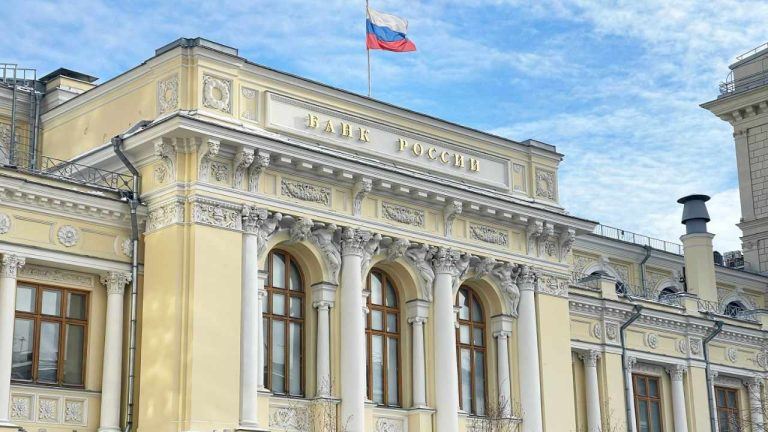 The Bank of Russia has highlighted the conditions it will need to consider when regulating the use of stablecoins for Russian individuals and companies. The bank stated that before a regulation is enacted, a thorough study of these assets and a discussion with the relevant actors of the market and the community around them should […]
The Bank of Russia has highlighted the conditions it will need to consider when regulating the use of stablecoins for Russian individuals and companies. The bank stated that before a regulation is enacted, a thorough study of these assets and a discussion with the relevant actors of the market and the community around them should […] Russia’s central bank has urged businesses to consider various payment solutions, including cryptocurrencies and digital assets, to manage transactions with foreign partners and counter Western sanctions. Bank of Russia Governor Elvira Nabiullina highlighted that the central bank has softened its stance on the use of cryptocurrencies in international payments. She also mentioned ongoing efforts to […]
Russia’s central bank has urged businesses to consider various payment solutions, including cryptocurrencies and digital assets, to manage transactions with foreign partners and counter Western sanctions. Bank of Russia Governor Elvira Nabiullina highlighted that the central bank has softened its stance on the use of cryptocurrencies in international payments. She also mentioned ongoing efforts to […] The Bank of Russia and Rosfinmonitoring revealed the existence of a ‘know your crypto customer’ system pilot, that aims to link the fiat operations of crypto users with their blockchain actions. The pilot, which has been ongoing since 2023, involves five banks in Russia and is expected to run until April, but can be extended. […]
The Bank of Russia and Rosfinmonitoring revealed the existence of a ‘know your crypto customer’ system pilot, that aims to link the fiat operations of crypto users with their blockchain actions. The pilot, which has been ongoing since 2023, involves five banks in Russia and is expected to run until April, but can be extended. […] Chairman of the Russian State Duma Committee on the Financial Market Anatoly Aksakov stated that digital financial assets, issued by institutions regulated by the central bank, could replace fiat channels for international settlements. Aksakov also acknowledged that while not being controlled for this use case, digital assets were already being used to settle international payments. […]
Chairman of the Russian State Duma Committee on the Financial Market Anatoly Aksakov stated that digital financial assets, issued by institutions regulated by the central bank, could replace fiat channels for international settlements. Aksakov also acknowledged that while not being controlled for this use case, digital assets were already being used to settle international payments. […] The Bank of Russia has announced that it will support accelerating the adoption of cryptocurrency payments for international settlements. According to Elvira Nabiullina, governor of the Bank of Russia, these crypto-based payments must be launched in a sandbox-style experimental regime. In contrast, payments with national digital assets will be launched without similar precautions. Bank of […]
The Bank of Russia has announced that it will support accelerating the adoption of cryptocurrency payments for international settlements. According to Elvira Nabiullina, governor of the Bank of Russia, these crypto-based payments must be launched in a sandbox-style experimental regime. In contrast, payments with national digital assets will be launched without similar precautions. Bank of […] The Bank of Russia noted that Russian nationals transacted $51 billion (4.78 trillion rubles) in crypto during 2023. According to an annual report issued by the bank, its investigations found that volume flows equivalent to the number, especially in bitcoin and ether, were attributed to Russian nationals in large exchanges. Bank of Russia Reports High […]
The Bank of Russia noted that Russian nationals transacted $51 billion (4.78 trillion rubles) in crypto during 2023. According to an annual report issued by the bank, its investigations found that volume flows equivalent to the number, especially in bitcoin and ether, were attributed to Russian nationals in large exchanges. Bank of Russia Reports High […] The Bank of Russia reported that the number of pyramid schemes and illegal lending providers in Russia rose to over 5,700 in 2023, an increase of 15.5% over the number detected in 2022. Specifically, the number of pyramid schemes detected increased by 46%, relying on the Internet and cryptocurrency as tools for promoting and carrying […]
The Bank of Russia reported that the number of pyramid schemes and illegal lending providers in Russia rose to over 5,700 in 2023, an increase of 15.5% over the number detected in 2022. Specifically, the number of pyramid schemes detected increased by 46%, relying on the Internet and cryptocurrency as tools for promoting and carrying […]
The most common hindrances cited include insufficient information about the technology (22%) and concerns about cybertheft and system failures (21%).
According to a recent survey conducted by the joint team of Saint Petersburg Exchange and the Russian Trading System (RTS), more than half of Russian citizens are willing to store their money in a central bank digital currency (CBDC). However, when it comes to storing more than 20,000 rubles (roughly $212), only 17% trust the digital ruble.
The survey involved over 2,000 respondents across the country aged 18–65, and its results were published in the local newspaper Izvestia on Aug. 24. According to the report, 58.3% of responders are theoretically ready to put their money into the CBDC.
But the majority of them (23.8%) would transfer only a sum of 5,000 ($53) to 20,000 rubles ($212) to digital money. 9% of respondents can imagine storing 20,00–50,000 rubles ($212–$529) in the CBDC, 2% — an amount up to 100,000 rubles ($1,058). As to the idea of storing all their money in the central bank digital currency, only 2.4% are willing to do it.
Related: Gold-backed BRICS currency will be ‘very hard’ to deliver: Lyn Alden
The most common hindrances cited include insufficient information about the technology (22%) and concerns about cybertheft and system failures (21%).
On Aug. 15, Russia began testing operations with digital rubles. The pilot tests involve the participation of 13 banks and a restricted group of their clients. The initial phase centers on perfecting fundamental operations. This phase prioritizes key processes including the establishment and funding of digital ruble accounts, facilitating individual-to-individual digital ruble transactions, streamlining automated payments, and innovatively employing QR codes for seamless purchase and service transactions
According to the first deputy governor of the Bank of Russia, Olga Skorobogatova, the bank’s strategy involves bringing the digital ruble into widespread use by 2025–2027.
Magazine: Should we ban ransomware payments? It’s an attractive but dangerous idea

According to Olga Skorobogatova, First Deputy Governor of the Bank of Russia, initiating pilot operations using genuine digital rubles represents a pivotal phase within the project.
The Bank of Russia (BoR) has revealed that it will begin testing operations for Russia’s central bank digital currency (CBDC) project with real digital rubles. The test will begin on August 15.
A statement released by the Bank of Russia indicates that the pilot tests will involve the participation of 13 banks and a restricted group of their clients.
According to Olga Skorobogatova, First Deputy Governor of the Bank of Russia, initiating pilot operations using genuine digital rubles represents a pivotal phase within the project. This step facilitates the examination of the digital ruble platform's functionality within an industrial context, the refinement of essential procedures in collaboration with clients, potential process adjustments and the assurance of a user-friendly and comprehensible client experience.
Skorobogatova added that the bank’s strategy involves bringing the digital ruble into widespread use, hinging on the outcomes of gradual testing and contingent upon the successful execution of comprehensive trials encompassing all operational possibilities involving the digital ruble. According to the deputy governor, It is expected that starting from 2025, citizens and businesses will be able to actively use the national digital currency at their own request.
As per the announcement, the initial phase of the pilot program will focus on refining fundamental processes, including the establishment and funding of digital ruble accounts (digital wallets), digital ruble transactions among individuals, uncomplicated automated payments, and the utilization of a QR code for transactions involving purchases and services.
Those taking part in the pilot initiative will have the opportunity to employ digital rubles for payments at 30 retail establishments situated across 11 cities in Russia. The intention is to broaden the roster of pilot participants by the conclusion of 2023, encompassing the inclusion of both individuals and businesses.
Related: Bank of Russia reveals digital ruble’s logo and commission fees
In 2024, the array of transactions will be enhanced, featuring an additional payment scenario utilizing a dynamic QR code and facilitating transfers between legal entities. Furthermore, the scope of templates for uncomplicated automated payments will be extended.
The introduction of the digital ruble pilot had previously been postponed indefinitely due to the fact that its legislation had only advanced through the initial reading in the State Duma, which constitutes the lower chamber of the Federal Assembly. Nevertheless, Russia proceeded with the central bank digital currency initiative, as President Vladimir Putin enacted the digital ruble legislation on July 24th.
Magazine: China expands CBDC’s tentacles, Malaysia is HK’s new crypto rival: Asia Express

From 2025 B2B transactions will cost $0,16 each, while individual customers will pay 0.3% of the total transaction sum when transferring to commercial accounts.
The central bank digital currency (CBDC) project, being developed by the Bank of Russia has now got its official logo. The Bank of Russia has also published commission fee rates, which would exceed zero points only in 2025.

Source: The Central Bank of Russia
On August 3, the Bank of Russia revealed the corporate identity of its digital currency. An international ruble symbol in a circle, the logo comes in four basic color combinations, which combine either red (or, more precisely, a Pantone Red 032C) and white or black and white.
Along with the logo, the Bank of Russia presented the commission fees for different types of operations with its CBDC. Until the end of 2024 all services will be free of charge, but starting from 2025 the B2B transactions would cost 15 rubles ($0,16) each, while individuals would pay 0.3% of the total transaction sum when transferring to commercial accounts and 0.2% when paying for civil services.
Related: Russian CBDC by 2025? What’s happening with the digital ruble
Russian President, Vladimir Putin, signed the digital ruble bill into law on July 24. The CBDC is officially scheduled to take effect from Aug. 1, 2023, starting with a pilot phase with thirteen local banks.
The Bank of Russia will be the principal operator of the digital ruble infrastructure. The currency will serve as a payment and transfer method. No one will be forced to use the CBDC, as it will operate along with cash and non-cash rubles, Bank of Russia governor Elvira Nabiullina has recently specified.
According to Bank of Russia deputy governor Olga Skorobogatova, the regulator doesn’t expect mass adoption of the digital ruble in Russia before 2025 or even 2027.
Private digital currencies remain largely unregulated in the country, as Russian lawmakers are continuing to postpone the introduction of cryptocurrency legislation. The last time State Duma official Anatoly Aksakov promised to pass four bills related to crypto mining, taxation and international settlement crypto, was in May 2023.
Magazine: Deposit risk. What do crypto exchanges really do with your money?